Are you thinking about buying a 4,000 watt generator and wondering what it can power? Don’t worry, you’re not alone. Many people are interested in purchasing a generator for emergency backup power or recreational use, but aren’t sure which size is best for their needs.
I have great news for you! Our team here at Generatorist has helped over 600,000 people find the information they need about generators and we’re here to help you too.
This article will help you understand what appliances and devices you can run on a 4000 watt generator and how to determine your wattage requirements.
Here’s what you need to know: A 4,000-watt generator typically provides either 33.3 amps at 120 volts or 16.6 amps at 240 volts. Some of the best options currently available on the market include the Westinghouse iGen4500, CHAMPION 4000 watt inverter generator or DuroMax XP4400E generator.
THE KEY TAKEAWAY:
A 4000 watt generator can run most household appliances, power tools, and RV/camping appliances such as a small window AC unit, fridge with a freezer, small well pump, washing machine, coffee maker, microwave oven, dishwasher, pressure cooker, toaster, TV, vacuum cleaner, and a couple of power tools.
However, you cannot run all of these devices simultaneously, and you need to be aware of the power consumption of each appliance:
- Small window AC unit – 1,200 watts
- Fridge with a freezer – 700 watts
- Small well pump (1/2 HP) – 1,000 watts
- Washing machine – 1,150 watts
- Coffee maker – 1,000 watts
- Microwave oven – 1,000 watts
- Dishwasher – 1,500 watts
- Pressure cooker – 700 watts
- Espresso machine – 1,300 watts
- Toaster – 850 watts
- Ceiling fan – 60 watts
- Vacuum cleaner – 200 watts
- TV – 85 watts
- Sump pump (1/2 HP) – 1,050 watts
- Small heating system – 500 watts
- Laptop – 50 watts
- VCR / DVD Player – 100 watts
- Smaller electric appliances – 400 watts
- A couple of power tools – 800 watts
- Medium radiant heater – 1,800 watts
- Bench grinder – 1,400 watts
- Hammer drill – 1,000 watts
- Radial arm saw – 2,000 watts
- Electric water heater – 4,000 watts
- Steam iron – 2,200 watts
Our list of over 100+ products and their power needs will help you calculate the actual requirements for running multiple appliances simultaneously.
Also, you need to know whether your generator has the correct number and type of outlets as some higher wattage appliances such as AC units may need different outlets than some low-wattage appliances.
STARTING WATTS VS RUNNING WATTS
There are two main wattage output numbers characterizing the amount of power a generator can produce: Running watts and Starting watts.
Running watts – The term “running watts” refers to the amount of power that a generator can consistently produce over a prolonged period of time. This is often represented as a lower number on the specifications of the generator.
Starting watts – The second, larger number, refers to the surge (or starting) watts – the maximum power your machine can produce over a short period of time. This number is typically higher than the running watts and is represented as a larger number on the generator specifications.
It’s important to note that many appliances and tools require more power when starting up than when they are running. So, it’s crucial to consider both the running and starting watts when choosing a generator.
By a 4,000 watt generator we refer to a machine that is able to produce 4,000 running watts. Its starting watts will vary depending on the brand and model of each generator, but based on our experience the range is somewhere between 4,300 – 5,250 surge watts.
Just don’t expect to run your whole house on this machine simultaneously as this will require a lot more power than any 4,000 watt generator provides.
If you are thinking about getting one, pick from Westinghouse iGen4500, CHAMPION 4000 watt inverter or DuroMax XP4400E. No matter which of these generators you choose, you can rest assured that you’re getting a high-quality, reliable, and efficient machine that will provide you with years of reliable power.
If you need an energy backup for your whole house without any limitations, you may consider getting a stand-by unit instead of a portable one. Here is a great calculator from Generac that will help you decide.
Usually, these generators are much more expensive and need to be installed by a professional electrician.
Here are our tips for choosing the best generator for your household and specific tips for contractors as well, in case you are interested.
Determining your
If you want to learn what electronic appliances will a 4,000 generator run, you need to get ready to do some math. Don’t worry, it will be a very simple process of adding up several numbers.
To determine what appliances you can run on this type of generator at the same time, you need to follow these steps:
- List all electronic appliances in your home you want to keep running in the case you are out of power (here is a great list full of appliances you might use)
- Write information from their name tags on required running and starting watts into a table (see examples below)
- Then you need to add up all the running watts required to operate your appliances
- The next step is to find the item with the highest additional starting watts
- Then add this number to your total running watts
- The final number represents the amount of starting watts your generator needs to provide
Here is an example of how to calculate the wattage requirements for a generator.
We have decided that in case of a weather-caused blackout, we would need only essentials such as a refrigerator with a freezer so our food will be safe, a lamp that will serve as an emergency light source, a small window AC unit to keep the temperature under control, a toaster, and a laptop.
| Selected Appliances | Rated (Running) Watts | Additional Starting Watts |
|---|---|---|
| Toaster | 850 W | 0 W |
| Refrigerator / Freezer | 700 W | 2,200 W |
| Laptop | 50 W | 0 W |
| Lamp (2 Lightbulbs) | 150 W | 0 W |
| Window AC (10,000 BTU) | 1,200 W | 3,600 W |
| TOTAL | 2,950 W | |
| 6,550 W |
As you can see in our example above, if we add up all running watts of our appliances we get the number 2,950 – so we are well within the 4,000 running watts limit (850 + 700 + 50 + 150 + 1,200 = 2,950).
However, we would need a generator that is capable of producing at least 6,550 surge (starting) watts to power all these appliances (2,950 + 3,600 = 6,550).
Just keep in mind that some electric appliances in your home may not have running watts provided on their data tags. If this is the case, you can estimate the running watts required thanks to the following formula:
Watts (W or kW) = Volts (V) x Amps (A)
Amps (A) = Watts (W or kW) / Volts (V)
So, as long as you have required Volts and Amps, you can easily convert them into an estimate of required running watts. Maybe you remember that this equation represents Ohm’s law from High School physics.
Luckily, there is a device called “appliance load tester” that you can get to determine how many watts each of your appliance takes. You can easily get one from Amazon and avoid all that physics equation.
If you need general estimates of wattage consumption for the most common electronic appliances, then take a look at our tables at the end of this guide. Just take these numbers as rough estimates.
You need to check each appliance / power tool in your home individually to see the precise wattage requirements.
How much can a 4000 watt generator run? Feel free to check out the wattage requirements of the most popular household appliances, RV & camping appliances or power tools for contractors here on Generatorist.
4000 Watt Generators
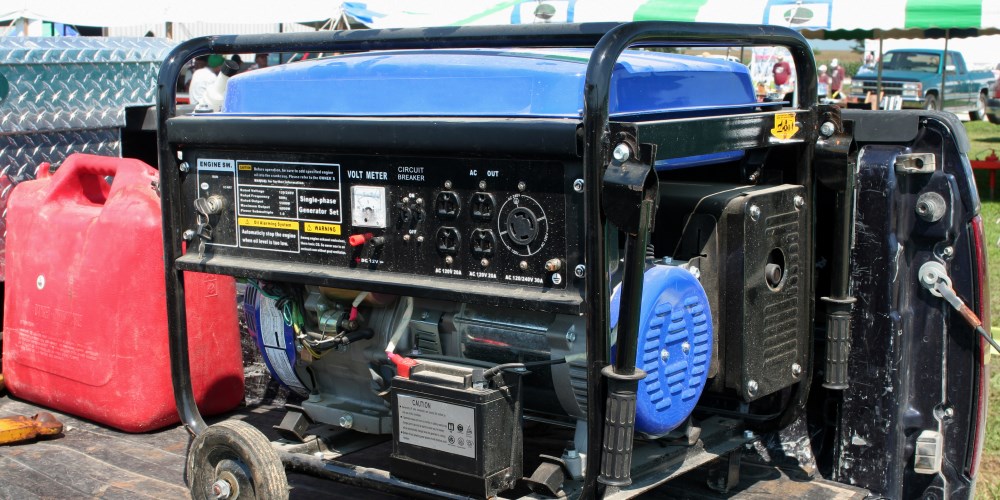
Because we got a lot of questions over time with regards to 4,000-watt generators, we have decided to add this FAQ section where you can look for helpful information.
If you have questions that are not answered here, feel free to contact us or leave your question in the comments section available at the end of this article.
In general, this type of machine will run almost all household appliances, power tools, RV and camping appliances, including:
- Small window AC unit – 1,200 watts
- Fridge with a freezer – 700 watts
- Small well pump (1/2 HP) – 1,000 watts
- Washing machine – 1,150 watts
- Coffee maker – 1,000 watts
- Microwave oven – 1,000 watts
- Dishwasher – 1,500 watts
- Pressure cooker – 700 watts
- Espresso machine – 1,300 watts
- Toaster – 850 watts
- Ceiling fan – 60 watts
- Vacuum cleaner – 200 watts
- TV – 85 watts
- Sump pump (1/2 HP) – 1,050 watts
- Small heating system – 500 watts
- Laptop – 50 watts
- VCR / DVD Player – 100 watts
- Smaller electric appliances – 400 watts
- A couple of power tools – 800 watts
- Medium radiant heater – 1,800 watts
- Bench grinder – 1,400 watts
- Hammer drill – 1,000 watts
- Radial arm saw – 2,000 watts
- Electric water heater – 4,000 watts
- Steam iron – 2,200 watts
To learn, whether you can run all these at the same time you need to know the power consumption of each appliance in your home.
There are some universal rules and precautions you need to follow when you want to run your generator safely.
The best document on this topic is the OSHA Fact Sheet: Using Portable Generators Safely and here is a quick summary:
- Never attach a generator directly to the electrical system of a structure (home, office, trailer, etc.) unless a qualified electrician has properly installed the generator with a transfer switch.
- Always plug electrical appliances directly into the generator using the manufacturer’s supplied cords or extension cords that are grounded (3-pronged). Inspect the cords to make sure they are fully intact and not damaged, cut or abraded.
- Use ground fault circuit interrupters (GFCIs), especially where electrical equipment is used in or around wet or damp locations. GFCIs shut off power when an electrical current is detected outside normal paths.
- Never use a generator indoors or in enclosed spaces such as garages, crawl spaces, and basements. NOTE: Open windows and doors may NOT prevent CO from building up when a generator is located in an enclosed space.
- If you or others show symptoms of CO poisoning—dizziness, headaches, nausea, tiredness – get to fresh air immediately and seek medical attention.
- Keep fuel containers away from flame producing and heat generating devices (such as the generator itself, water heaters, cigarettes, lighters, and matches).
In general, a 4,000 running watts generator doesn’t provide enough power to run a heat pump or electric furnace. However, answering this question is really hard without knowing the exact running and starting watts required by your electric appliance.
Please, contact the manufacturer of your pump or furnace to learn more info on its wattage requirements.
Sadly, there is not a single answer to this question. To learn, whether you can run your welder on a 4,000-watt portable generator you need to know the power requirements of your welder (see the data tag or user manual you got to your welder).
However, based on the information we were able to learn, the best option is to get a special generator that has been manufactured for welding purposes such as LIFAN AXQ-200A to be able to harness the full potential of your welder.
You can shop for some good options on Home Depot or Amazon.com
In general, a 4,000 – 4,300 running watts generator should provide enough power to run a small air compressor without any issues. However, answering this question is really hard without knowing the exact running and starting watts required by your air compressor.
I have found rough estimates for different types of compressors:
- 1/2 Horse Power – It takes 975 running watts and 1,600 starting watts.
- 1 Horse Power – It takes 1,600 running watts and 4,500 starting watts.
As you can see in the estimates above, the issue is not running watts but starting watts. To get the precise numbers, you will need to find the voltage, amperage, and horsepower information on the info-plate of your compressor.
Then, all it takes to learn required wattage is to apply this equation:
Watts (W or kW) = Volts (V) x Amps (A)
In general, a 4,000 – 4,300 running watts generator should provide enough power to run a small RV AC unit (11000 BTU) without any issues. However, answering this question is really hard without knowing the exact running and starting watts required by your AC unit.
I have found rough estimates for different types of RV air conditioning units:
- 11000 BTU – It takes 1,050 running watts and 1,600 starting watts.
- 13000 BTU – It takes 1,800 running watts and 2,800 starting watts.
- 15000 BTU – It takes 2,000 running watts and 3,300 starting watts.
As you can see in the estimates above, the issue is not running watts but starting watts. To get the precise numbers, you will need to find the voltage and amperage information on the info-plate of your RV AC unit.
Then, all it takes to learn required wattage is to apply this equation:
Watts (W or kW) = Volts (V) x Amps (A)
In general, a 4,000 generator should provide enough power to run a circular saw. A rough estimate of the power requirements of a heavy-duty 7.25″ circular saw is as follows:
- 1,400 running watts
- 2,300 starting watts
So, as long as your generator offers at least 2,500 starting watts (we recommend getting slightly more power than needed), you should be able to run your machine on this type of generator.
A rough estimate of the energy requirements of a space heater is as follows:
- 1,800 running watts
- 1,800 starting watts
As you can see, you can easily run your space heater with a 4,000 – 4,300 running watts generator. Just don’t forget to double-check the name tag on your appliance to learn the precise wattage requirements.
In general, a common microwave needs around 1000 watts to operate. A 4000-watt generator has at least 4,000 running and 4300 starting watts so you can run your microwave pretty easily.
Just don’t forget to check the nameplate on your appliance to learn the precise wattage requirements.
In general, a refrigerator takes around 1200 surge watts at the beginning while the compressor kicks in and then it gradually drops down to around 200 running watts. As you can see, each and every generator in this article could run a mid-sized refrigerator.
If you choose at least a 2000 starting watts inverter generator (Yamaha EF2000iSv2, WEN 56200i, or Generac GP2200i), you can power any modern refrigerator with a freezer easily.
Most fridges require about 800 – 1200 starting watts and 4000 watts is more than enough to power them safely.
Also, if your generator has a high total harmonic distortion, your fridge (especially if you have a modern type) may get damaged (that is why we recommend getting an inverter type of generator).
The size of a generator depends on the type of fridge you want to power:
- While modern appliances have much lower power consumption (around 300 – 400 watts), even while the compressor starts to kick in, the older types of fridges are going to need a bigger power supply (around 300 – 1,200 watts).
- Another aspect that will affect the required size of your generator is whether your fridge also comes with a freezer. In such a case it will require even more power (add 80 – 100 watts to those numbers mentioned above).
Learn more about the power consumption of different types of refrigerators in our guide FAQ: What Size Generator Do I Need to Run a Refrigerator?
Definitely. As long as your generator is an inverter with a low total harmonic distortion, then you can run your TV safely on a 4,000-watt generator.
Here are some rough estimates of wattage requirements of various TVs:
- Tube type – It takes 300 running watts and 300 starting watts.
- Flat Screen (20”) – It takes 120 running watts and 120 starting watts.
- Flat Screen (46″) – It takes 190 running watts and 190 starting watts.
As you can see, you will have enough spare power to run your DVD player which takes approximately 350 running and 350 starting watts as well.
Usually, a 4,000 – 4,300 running watts generator should provide enough power to run a small sump pump without any issues. However, answering this question is really hard without knowing the exact running and starting watts required by your pump.
I have found rough estimates for different types of sump pumps:
- 1/3 Horse Power – It takes 800 running watts and 1,300 starting watts.
- 1/2 Horse Power – It takes 1,050 running watts and 2,150 starting watts.
As you can see in the estimates above, the issue is not running watts but starting watts. To get the precise numbers, you will need to find the voltage, amperage, and horsepower information on the info-plate of your pump.
Then, all it takes to learn required wattage is to apply this equation:
Watts (W or kW) = Volts (V) x Amps (A)
Just keep in mind that your sump pump will probably require a 240V outlet on your generator.
In general, a 4,000 – 4,300 running watts generator should provide enough power to run a small well pump without any issues. However, answering this question is really hard without knowing the exact running and starting watts required by your water pump.
I have found rough estimates for different types of pumps:
- 1/3 Horse Power – It takes 750 running watts and 1,500 starting watts.
- 1/2 Horse Power – It takes 1,000 running watts and 2,100 starting watts.
- 3/4 Horse Power – It takes 1,500 running watts and 3,000 starting watts.
- 1 Horse Power – It takes 2,000 running watts and 4,000 starting watts.
- 1 & 1/2 Horse Power – It takes 2,500 running watts and 5,000 starting watts.
As you can see in the estimates above, the issue is not running watts but starting watts. To get the precise numbers, you will need to find the voltage, amperage, and horsepower information on the info-plate of your pump.
Then, all it takes to learn required wattage is to apply this equation:
Watts (W or kW) = Volts (V) x Amps (A)
We have serious doubts that a 4000-watt generator would provide enough power to run a central AC unit. We would rather go for a very small emergency window AC unit as 4,000-watt generators may have too little starting power.
However, the answer to this question really depends on the number of running and starting watts your AC unit requires.
Obviously, these numbers vary from one unit to another and are based on the cooling ability of individual models and brands. That is why you need to look for the following data on the name tag of your central AC unit:
- LRA (Locked Rotor Amps) – This number represents the current you can expect under starting conditions when you apply full voltage.
- RLA (Rated Load Amps) – This number represents the maximum current a compressor should draw under any operating conditions.
- FLA (Full Load Amps) – This number represents the same as the Rated Load Amps.
You need to take into consideration the amps for both the compressor and the fan unit. To determine, if your 4,000-watt generator can run a central AC, please consult its manufacturer or a professional electrician.
Keep in mind that a typical central air unit runs on 208/240 volts and is often permanently mounted and hardwired into the electrical system of your house. That is why to safely run this electronic appliance you need to connect your generator through a transfer switch.
Actually, you should always connect your generator through a transfer switch if you don’t want to damage your appliances or endanger people who may be working on electric lines in your neighborhood.
Usually, a 4000 watt gasoline generator has a 4-stroke engine. If this is the case, you will need to use either SAE 30 (if you live in a warmer climate) or a SAE 10W-30 if you are going to use it in a colder climate (do not forget to double-check with your owner´s manual).
However, there are several things you need to consider while choosing the oil for your machine:
- Whether you got a 2-stroke or a 4-stroke engine
- Starting and operating temperatures
- Type of fuel your machine runs on
- Certifications and classifications of the oil
- Reputation of the brand and company producing the oil
If you need to learn more information on how to choose the best oil for your generator, then consult our guide that is available right here. We provide you also with a list of best brands in various categories of oil.
In general, a 4,000-watt generator provides approximately 33.3 amps, in case of 120 volts or 16.6 amps in case of 240 volts. To learn more, you should check out the owner´s manual to the machine you want to buy.
Actually, identifying how many amps there are in a 4000 running watt generator is a very simple process. All you have to do is to apply the following formula:
Amps (A) = Watts (W or kW) / Volts (V)
You need to divide the wattage by the voltage. So, in this case, you need to divide 4000 by 120 or 240 to get the correct numbers. In case you are looking for power requirements of household appliances, here is our helpful list of over 100+ products and their power needs.
Here is our handy cheat sheet:
- 500 Watts, 120 V = 4.2 A, 240 V = 2.1 A
- 1000 Watts, 120 V = 8.3 A, 240 V = 4.2 A
- 2000 Watts, 120 V = 16.7 A, 240 V = 8.3 A
- 3000 Watts, 120 V = 25.0 A, 240 V = 12.5 A
- 4000 Watts, 120 V = 33.3 A, 240 V = 16.7 A
- 5000 Watts, 120 V = 41.7 A, 240 V = 20.8 A
- 6000 Watts, 120 V = 50.0 A, 240 V = 25.0 A
- 7000 Watts, 120 V = 58.3 A, 240 V = 29.2 A
- 8000 Watts, 120 V = 66.7 A, 240 V = 33.3 A
- 9000 Watts, 120 V = 75.0 A, 240 V = 37.5 A
- 10000 Watts, 120 V = 83.3 A, 240 V = 41.7 A
- 12000 Watts, 120 V = 100.0 A, 240 V = 50.0 A
- 14000 Watts, 120 V = 116.7 A, 240 V = 58.3 A
- 16000 Watts, 120 V = 133.3 A, 240 V = 66.7 A
This question doesn’t have an universal answer as each generator has unique fuel consumption and capacity of the fuel tank. From our experience an average 4,000 watt generator runs for approximately 10.2 hours on a 50% load.
This number is a median that we got after looking at the run time of over 13 generators that provide around 4,000 running watts.
Here are some examples:
- A-IPOWER SUA5000 – 4,250 running watts – 9 hr on a 50% load (4.0 gal)
- Westinghouse iGen4500 – 3,700 running watts – 18 hr on a 25% load (3.4 gal)
- Pulsar PG5250 – 4,250 running watts – 8 hr on a 50% load (4.0 gal)
- Champion 4000 – 3,500 running watts – 17 hr on a 25% load (2.9 gal)
- DuroMax XP4400E – 3,500 running watts – 11.4 hr on a 50% load (3.9 gal)
- Yamaha EF4500iSE – 4,000 running watts – 15.2 hr on a 25% load (4.5 gal)
- DEWALT DXGNR4000 – 4,000 running watts – 10.5 hr on a 50% load (3.4 gal)
- LIFAN ESI4000iER-EFI – 3,800 running watts – 12 hr on a 50% load (3.5 gal)
- DuroMax XP5500EH – 4,500 running watts – 8 hr on a 50% load (4.0 gal)
One of the most notable advantages of inverter generators is that they’re perfect for powering small devices, such as computers, televisions, and smartphones.
If you prioritize things like fuel efficiency, quietness, portability, and the ability to safely power sensitive electronics, you really can’t go wrong with an inverter generator.
While some traditional generators can produce upwards of 17,000 watts, inverter generators don’t usually reach figures higher than around 7,000.
PROS OF AN INVERTER GENERATOR:
- Produces power with significantly lower THD
- Lighter and smaller
- More energy efficient than traditional generators
- Much lower fuel consumption
- Parallel capability
- Safe for sensitive electronics like laptops or mobile phones
- Quieter than traditional generators
CONS OF AN INVERTER GENERATOR:
- Significantly more expensive than traditional generators
- Lower power output – limited wattage range
- Costly repairs and servicing
- Limited fuel options
For a comprehensive overview of inverter generators and how they work, read our guide here: What Is an Inverter Generator & How Does It Work? (Pros + Cons Included)
There are several features you can consider while shopping for the best generator for your home. Our team here at Generatorist recommends the following:
- At least 1 alternative fuel source if gasoline is not available
- Electric start with manual recoil backup for convenient use by anyone
- Included maintenance-free electric battery with a trickle charger
- Built-in inverter or automatic voltage regulation
- Automatic idle control for reduced fuel consumption
- Durable frame and steel fuel tank
- Fuel gauge and low-oil shutoff
- Manual fuel-shutoff switch/valve
- Longer run time
- OHV (overhead valve) engine
- Spark arrestor
- Multiple types of outlets with covers
- At least one outlet for higher wattage items (30 amp)
- Folding handles with a wheel kit
To read more about how to pick the best generator for your home, check out our helpful guide linked above.
We recommend you consider the following features:
- Fuel Type – For job contractors, we recommend generators that are running on diesel as this type of fuel is more frequently used in other machines that are usually present on the job site. This way, your fuel management will be much easier.
- Long run time – The worst thing that can happen on a job-site is a downtime as it leads to profit loss. Every refueling takes your machine out of service for some time. Therefore, it is vital to get a generator that can run for a whole shift without the need to refuel. This way, you can do the refueling with basic maintenance after the work shift is over.
- Large gas tank – Although a large gas tank will diminish the portability of your generator, it will enable you to run it for a longer period of time without the need to refuel.
- Automatic idle control – The automatic idle control (also known as Eco Throttle or Smart Throttle) can save you a lot of fuel costs and can reduce the noise of your generator. It automatically adapts the rotations of your engine in relation to the actual load. If your generator runs idle, this system can significantly reduce the number of rotations per minute.
To discover more features you should look for in your next generator, read our tips in this article here: Choosing The Best Generator for Contractors
There is no single answer to this question. Actually, there are several features of your 4000 watt generator you need to consider while choosing your transfer switch.
We are going to cover this topic soon but in the meantime, feel free to read this comprehensive guide from Electric Generators Direct: How to Pick the Perfect Manual Transfer Switch.
If you are looking for an RV generator, our advice is to choose a machine that is powerful but still quiet. Ideally, go for an inverter.
There are only two inverters in this category of generators that are also quiet at the same time:
- Yamaha EF4500iSE
- Wanco WI4300
There is also one RV ready generator in this category – the Pulsar PG5250B. If you want to get any other unit from this list, then you need to get a necessary set of adapters (also called dogbones) to easily connect your RV through either a 20 or a 30 amp outlets.
So pick a generator that fits your needs the most and if it is not RV ready, don’t forget to get the correct adapter.
Finding reliable information on the “noisiness” of generators is a tough job to do. However, based on our findings, we can list the following machines as “quietest”:
- Yamaha EF4500iSE
- Wanco WI4300
In general, if you want a portable generator that is powerful but also quiet at the same time, then go for an inverter. Sadly, these machines are much more expensive than regular generators.
If you are looking for a 4,000 -4,300 running watts generator that offers the most comfortable electric start, then we have only two options that stand out:
- Yamaha EF4500iSE (4,000 running / 4,500 starting watts)
- Wanco WI4300 (4,000 running / 4,300 starting watts)
Both machines are inverters and provide clean power. So choose one according to the maximum starting and running watts you require.
There are two 4,000 generators that can run on propane as well:
- Pulsar PG5250B (dual fuel – 4250 running watts generator)
- QuipAll 5250DF (dual fuel – 4,000 running watts generator)
Both of these machines provide a good quality-vs-price ratio.
If you are looking for the best inverter generator that provides 4,000 – 4,300 running watts, then there are two options for you to choose from.
Based on our research, the best inverters in this category are:
- Yamaha EF4500iSE (4,000 running / 4,500 starting watts)
- Wanco WI4300 (4,000 running / 4,300 starting watts)
Just keep in mind that although inverters are running quietly, they are on the more expensive side.
Looking for a 4000 watt generator?
Essential Appliances
| Household Appliances | Rated (Running) Watts | Additional Surge Watts |
|---|---|---|
| Evaporative AC | 2,600 W | 0 W |
| Heat Pump | 4,700 W | 4,500 W |
| Humidifier (13 Gal.) | 175 W | 0 W |
| Electric Water Heater | 4,000 W | 0 W |
| Well Water Pump (1/2 HP) | 1,000 W | 2,100 W |
| Window AC (10,000 BTU) | 1,200 W | 3,600 W |
| Window AC (12,000 BTU) | 3,250 W | 9,750 W |
| Central AC (10,000 BTU) | 1,500 W | 4,500 W |
| Central AC (24,000 BTU) | 3,800 W | 11,400 W |
| Sump Pump (1/3 HP) | 800 W | 1,300 W |
| Sump Pump (1/2 HP) | 1,050 W | 2,150 W |
| Furnace Fan Blower (1/3 HP) | 700 W | 1,400 W |
| Furnace Fan Blower (1/2 HP) | 800 W | 2,350 W |
| Garage Door Opener (1/2 HP) | 875 W | 2,350 W |
| Light Bulb (Common) | 75 W | 0 W |
| Space Heater | 1,800 W | 0 W |
| Ceiling Fan | 60 W | 70 W |
| Dehumidifier | 240 W | 0 W |
| Tube Light (1500mm) | 22 W | 0 W |
| Night Light | 1 W | 0 W |
| Electric Heater (Fan) | 2,000 W | 1,000 W |
| Electric Thermal Radiator | 500 W | 0 W |
| Light Bulb (LED) | 9 W | 0 W |
| Electric Water Heater (Tankless) | 6,600 W | 2,200 W |
| Electric Water Heater (Immersion) | 3,000 W | 0 W |
| Oversink Water Heater (Hand Wash) | 3,000 W | 0 W |
| Central AC (40,000 BTU) | 6,000 W | 6,700 W |
Kitchen Appliances
| Household Appliances | Rated (Running) Watts | Additional Surge Watts |
|---|---|---|
| Toaster | 850 W | 0 W |
| Microwave | 1,000 W | 0 W |
| Refrigerator / Freezer | 700 W | 2,200 W |
| Coffee Maker | 1,000 W | 0 W |
| Electric Stove (8" Element) | 2,100 W | 0 W |
| Wine Cooler (18 Bottles) | 83 W | 0 W |
| Deep Freezer | 500 W | 1,500 W |
| Electric Can Opener | 170 W | 0 W |
| Dishwasher | 1,500 W | 1,500 W |
| Food Processor/Blender | 400 W | 0 W |
| Electric Kettle | 1,200 W | 3,000 W |
| Food Dehydrator | 800 W | 0 W |
| Fryer | 1,000 W | 0 W |
| Pressure Cooker | 700 W | 0 W |
| Rice Cooker | 200 W | 500 W |
| Slow Cooker | 160 W | 20 W |
| Steriliser | 650 W | 0 W |
| Water Dispenser | 100 W | 0 W |
| Sandwich Maker | 700 W | 300 W |
| Percolator | 800 W | 300 W |
| Electric Oven | 2,150 W | 0 W |
| Espresso Coffee Machine | 1,300 W | 200 W |
| Induction Hob (Per Hob) | 1,400 W | 400 W |
| Cooker Hood | 20 W | 10 W |
| Air Fryer | 1,500 W | 0 W |
| Water Filter & Cooler | 70 W | 30 W |
| Hot Water Dispenser | 1,200 W | 100 W |
| Side-by-Side Fridge | 800 W | 1,200 W |
| Modern Fridge (2001-2020) | 400 W | 600 W |
| Smart Fridge | 500 W | 750 W |
Laundry Appliances
| Household Appliances | Rated (Running) Watts | Additional Surge Watts |
|---|---|---|
| Clothes Dryer (Gas) | 700 W | 1,800 W |
| Clothes Dryer (Electric) | 5,400 W | 6,750 W |
| Hair Dryer | 1,250 W | 0 W |
| Iron | 1,200 W | 0 W |
| Washing Machine | 1,150 W | 2,250 W |
| Curling Iron | 1,500 W | 0 W |
| Electric Shaver | 15 W | 20 W |
| Vacuum Cleaner | 200 W | 200 W |
| Bathroom Towel Heater | 60 W | 90 W |
| Extractor Fan | 12 W | 0 W |
| Electric Shaver | 15 W | 5 W |
| Heated Bathroom Mirror | 50 W | 50 W |
| Steam Iron | 2,200 W | 300 W |
| Straightening Iron | 75 W | 300 W |
| Power Shower | 7,500 W | 10,500 W |
Entertainment Appliances
| Household Appliances | Rated (Running) Watts | Additional Surge Watts |
|---|---|---|
| Laptop | 50 W | 0 W |
| Stereo | 450 W | 0 W |
| Television (22" LED) | 17 W | 0 W |
| Television (49" LED) | 85 W | 0 W |
| Television (82" LED) | 230 W | 65 W |
| Television (CRT) | 500 W | 0 W |
| VCR / DVD Player | 100 W | 0 W |
| Video Game System | 40 W | 0 W |
| Monitor | 200 - 250 W | 0 W |
| Home Internet Router | 5 W | 15 W |
| Home Phone | 3 W | 5 W |
| Playstation 4 | 85 W | 5 W |
| Nintendo Switch AC Adapter | 7 W | 33 W |
| Amazon Echo | 3 W | 0 W |
| Amazon Echo Show | 2 W | 2 W |
| Apple TV | 3 W | 3 W |
| Computer Monitor | 25 W | 5 W |
| Desktop Computer | 100 W | 350 W |
| Xbox One | 50 W | 60 W |
| Mi Box | 5 W | 2 W |
| Set Top Box | 27 W | 3 W |
| Home Sound System | 95 W | 0 W |
| Guitar Amplifier | 20 W | 10 W |
| AV Receiver | 450 W | 0 W |
Other Appliances
| Household Appliances | Rated (Running) Watts | Additional Surge Watts |
|---|---|---|
| Clock Radio | 50 - 200 W | 0 W |
| Fax | 60 - 80 W | 0 W |
| Printer (Laser) | 600 W | 200 W |
| Printer (Inkjet) | 20 W | 10 W |
| Security System | 500 W | 0 W |
| Garage Door Opener (1/2 HP) | 875 W | 2,350 W |
| Copy Machine | 1,600 W | 0 W |
| Cell Phone Battery Charger | 25 W | 0 W |
| Outdoor Light String | 250 W | 0 W |
| Electric Mower | 1,500 W | 0 W |
| Paper Shredder | 200 W | 220 W |
| Projector | 220 W | 270 W |
| Scanner | 10 W | 18 W |
| Electric Trimmer | 300 W | 500 W |
| Treadmill | 280 W | 900 W |
| Tablet Charger | 10 W | 5 W |
| Sewing Machine | 70 W | 10 W |
| Air Purifier | 25 W | 5 W |
| DAB Mains Radio | 5 W | 4 W |
| EV Home Charger | 1,600 W | 1,800 W |
| Electric Blanket | 200 W | 0 W |
| Electric Doorbell Transformer | 2 W | 0 W |
| Water Feature | 35 W | 0 W |
| Fan (Pedestal) | 50 W | 10 W |
| Fan (Table) | 10 W | 15 W |
| Fan (Wall) | 45 W | 15 W |
| 2-Way Radio (12A) | 360 W | 0 W |
| 2-Way Radio (23A) | 840 W | 0 W |
| 2-Way Radio (35A) | 960 W | 0 W |
power tools & machines
| Power tools | Rated (Running) Watts | Additional Surge Watts |
|---|---|---|
| Table Saw (10") | 1,800 W | 2,700 W |
| Drain Cleaner | 250 W | 0 W |
| Concrete Vibrator (2.00 HP) | 1,800 W | 3,600 W |
| Concrete Vibrator (1.00 HP) | 1,100 W | 2,500 W |
| Concrete Vibrator (0.75 HP) | 850 W | 1,900 W |
| Radial Arm Saw | 2,000 W | 2,000 W |
| Circular Saw (7.25") | 1,400 W | 4,200 W |
| Air Compressor (0.25 HP) | 975 W | 1,600 W |
| Air Compressor (0.50 HP) | 1,000 W | 2,000 W |
| Air Compressor (1.50 HP) | 2,200 W | 6,000 W |
| Air Compressor (2.00 HP) | 2,800 W | 7,700 W |
| Air Compressor (1.00 HP) | 1,600 W | 4,500 W |
| Miter Saw (10") | 1,800 W | 1,800 W |
| Reciprocating Saw | 960 W | 960 W |
| Electric Drill | 600 W | 900 W |
| Belt Sander | 1,200 W | 2,400 W |
| Bench Grinder | 1,400 W | 2,500 W |
| Chain Saw 12” (1.5 HP) | 900 W | 0 W |
| Jig Saw | 300 W | 300 W |
| High-Pressure Washer (1.00 HP) | 1,200 W | 3,600 W |
| Rebar Cutter (1") | 2,800 W | 0 W |
| Disk Sander (9") | 1,200 W | 2,600 W |
| Orbital Sander | 1,200 W | 2,600 W |
| Impact Wrench (1") | 1,200 W | 1,400 W |
| Charger (Cordless Drill) | 70 W | 80 W |
| Airless Sprayer (0.33 HP) | 600 W | 1,200 W |
| Hammer Drill | 1,000 W | 3,000 W |
| Welder (Electric) | 7,800 W | 0 W |
| Jointer/Planer | 1,800 W | 1,800 W |
Essential Equipment
| Power tools | Rated (Running) Watts | Additional Surge Watts |
|---|---|---|
| Floodlight | 1,000 W | 0 W |
| Heater (Liquid Fuel 50,000 BTU) | 225 W | 675 W |
| Heater (Liquid Fuel 100,000 BTU) | 420 W | 1,260 W |
| Heater (Liquid Fuel 150,000 BTU) | 625 W | 1,875 W |
| Sump Pump (1 HP / 230 V) | 715 W | 7,200 W |
| Sump Pump (1 HP / 115 V) | 1,440 W | 7,500 W |
| Quartz Halogen Work Light (1000 W) | 1,000 W | 0 W |
| Quartz Halogen Work Light (500 W) | 500 W | 0 W |
| Quartz Halogen Work Light (300 W) | 300 W | 0 W |
Farm Equipment
| Power tools | Rated (Running) Watts | Additional Surge Watts |
|---|---|---|
| Electric Fence (25 Miles) | 250 W | 250 W |
| Milk Cooler | 1,100 W | 1,800 W |
| Milker / Vacuum Pump (2.00 HP) | 1,000 W | 2,300 W |
Gardening Power Tools
| Power Tools | Rated (Running) Watts | Additional Surge Watts |
|---|---|---|
| Electric Strimmer | 300 W | 500 W |
| Electric Mower | 1,500 W | 0 W |
| Hedge Trimmer | 600 W | 450 W |
| Weed Cutter | 600 W | 500 W |
| Chain Saw 12” (1.5 HP) | 900 W | 0 W |
| Cultivator (1/3 HP) | 700 W | 1,400 W |
| Electric Leaf Blower (Handheld) | 2,500 W | 0 W |
Essential Appliances
| Camping / RV Appliance | Rated (Running) Watts | Additional Surge Watts |
|---|---|---|
| Space Heater | 1,800 W | 1,800 W |
| 4 Light Bulbs (75W) | 300 W | 300 W |
| Heating Pad | 250 W | 250 W |
| RV Roof-Top AC (13,500 BTU) | 1,500 W | 1,000 W |
| RV Roof-Top AC (15,000 BTU) | 2,000 W | 1,300 W |
| RV Roof-Top AC (11,000 BTU) | 1,010 W | 590 W |
| Furnace Fan (1/3 HP) | 700 W | 1,400 W |
| Electric Blanket | 80 W | 1,250 W |
| Fan | 200 W | 200 W |
| Electric Water Heater (6 Gal.) | 1,440 W | 1,440 W |
| Dehumidifier | 785 W | 1250 W |
Washing Appliances
| Camping / RV Appliance | Rated (Running) Watts | Additional Surge Watts |
|---|---|---|
| Vacuum | 1,100 W | 1,100 W |
| Curling Iron | 800 W | 800 W |
| Shaver | 35 W | 35 W |
| Blow Drier (Hair) | 1,250 W | 1,250 W |
| Iron | 1,200 W | 1,200 W |
| Clothes Washer | 1,150 W | 2,300 W |
Kitchen Appliances
| Camping / RV Appliance | Rated (Running) Watts | Additional Surge Watts |
|---|---|---|
| Electric Can Opener | 170 W | 0 W |
| Hot Plate | 1,200 W | 1,725 W |
| Waffle Iron | 1,200 W | 1,725 W |
| Electric Grill | 1,650 W | 1,650 W |
| Deep Fryer | 1,200 W | 1,200 W |
| Chest Freezer | 450 W | 900 W |
| Slow Cooker | 170 W | 270 W |
| Toaster | 850 - 1,250 W | 850 - 1,250 W |
| Toaster Oven | 1,200 W | 1,200 W |
| Dorm Size Refrigerator | 350 W | 500 W |
| Microwave (635W Cooking Power) | 635 W | 800 W |
| Electric Fry Pan | 1,200 W | 1,200 W |
| Coffee Maker | 800 W | 800 W |
| Corn Popper | 275 W | 275 W |
| Crockpot | 250 W | 250 W |
| Blender | 350 W | 500 W |
Entertainment Appliances
| Camping / RV Appliance | Rated (Running) Watts | Additional Surge Watts |
|---|---|---|
| AM/FM Cassette | 10 W | 10 W |
| Stereo | 450 W | 450 W |
| VCR | 100 W | 100 W |
| Satellite Dish & Receiver | 30 W | 250 W |
| Radio 2-Way | 360 W | 960 W |
| 27" Color TV | 500 W | 500 W |
| 19" Color TV | 160 W | 160 W |
| 12" B&W TV | 30 W | 30 W |
| Desktop Computer | 600 W | 800 W |
| Laptop | 50 W | 0 W |
| Printer | 500 W | 500 W |
| CD/DVD Player | 50 W | 200 W |
| Clock Radio | 100 W | 100 W |
Other Appliances
| Camping / RV Appliance | Rated (Running) Watts | Additional Surge Watts |
|---|---|---|
| Battery Charger (Cell Phone) | 25 W | 0 W |
| Inflator Pump | 50 W | 150 W |
About Generatorist

Matthew Gerther
Founder, Generator enthusiast
Our aim here at the Generatorist is to become the No. 1 resource for all things related to generators & your power needs. We have helped over 600,000 visitors with our tips, articles and reviews and we will help you as well.
Our work has been featured in many publications around the world – Yahoo.com, Telegram.com, PaylessPower.com, PopSci.com, TopTenReviews.com, TechRepublic.com, iRV2.com, ThePrepared.com, Renogy.com or ADT Solar. Generators are our passion, and we strive to provide the most reliable & most comprehensive information out there.

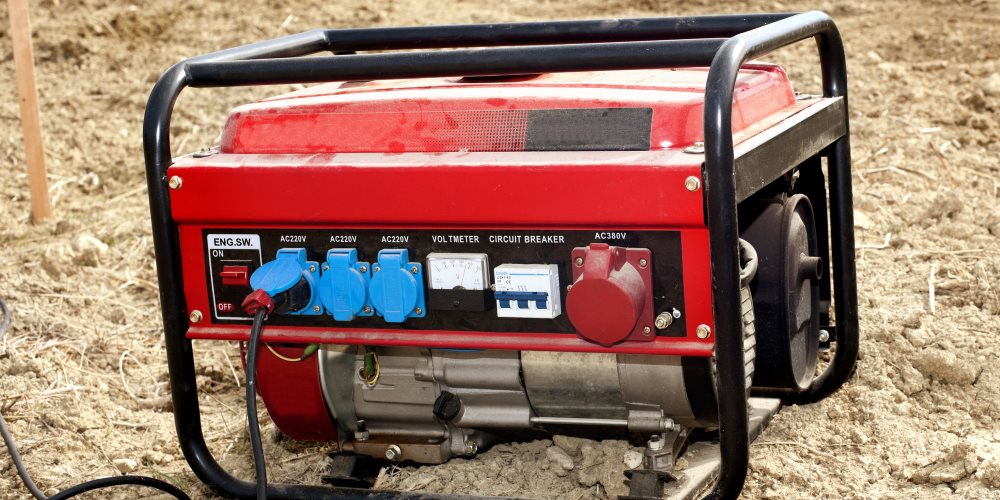

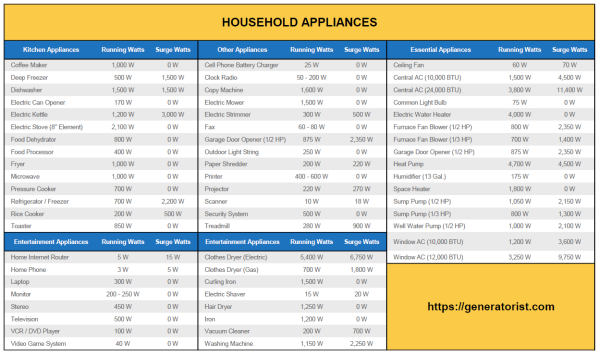
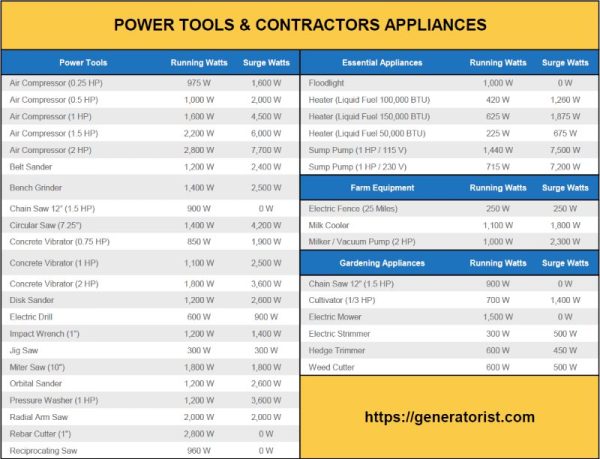
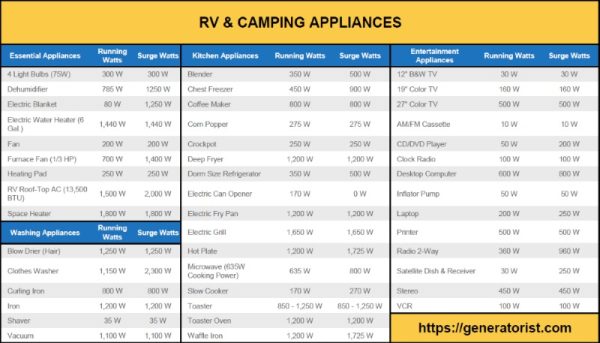
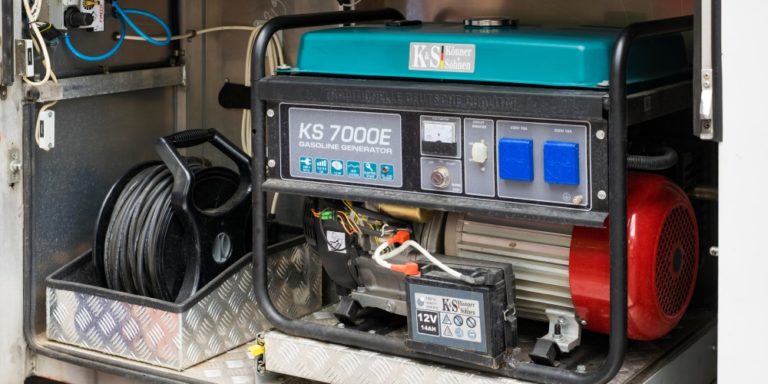
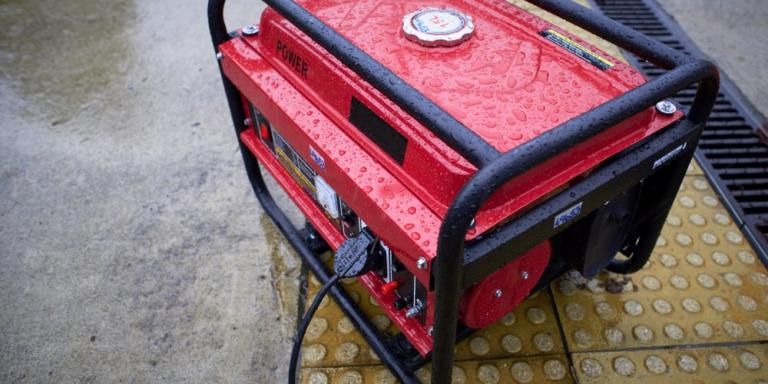
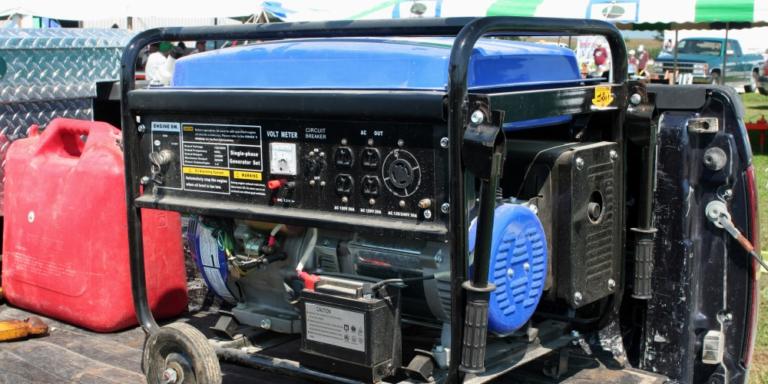

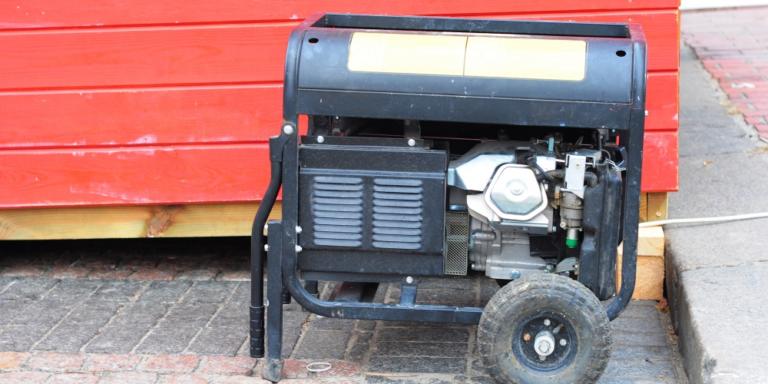
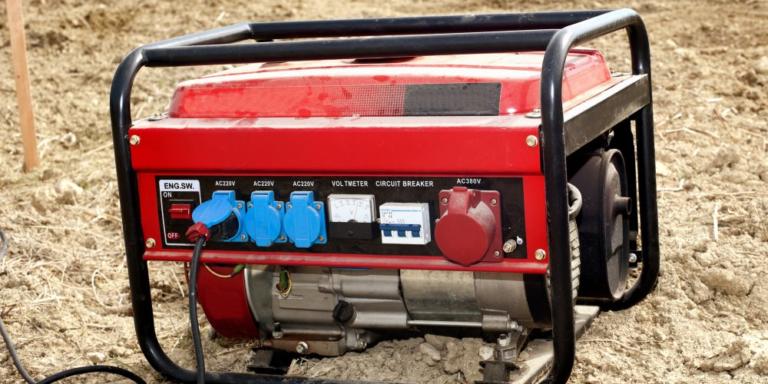
5 thoughts on “FAQ: What Will a 4000 Watt Generator Run?”
Does it need to be grounded
Hey Adam,
Sure, every generator needs to be grounded before you are going to start it. Otherwise, you are risking electrocution that could kill you.
Hi. I looked, but I do not see an answer to my questions? So, I probably didn’t do it right. Worried about another winter storm in North Texas, I don’t need to run my total house hold. I just want to run safely 2 ceramic tower heaters (one at each end) to keep hopefully pipes from bursting. They are 120 v-60-hz-1500w each. Can you recommend what size inverter generator? Thanks.
Hey Robert,
could you please provide more details about your space heaters? Brand and product number, and are those 1500w starting watts or running watts?
Thanks
Can you please suggest the Best lightweight Portable Generator for Camping